
views
Using the Water Gun

Purchase a water gun. Visit your local pharmacy, toy store, or discount retailer to purchase a water gun. Buy a smaller gun that you can carry around with you, and one that you can easily hide in your pants pocket or in your waistband. Purchase water guns that shoot streams of water as opposed to mists of water. Alternatively, you can purchase a spray bottle, but these are more difficult to carry around with you.
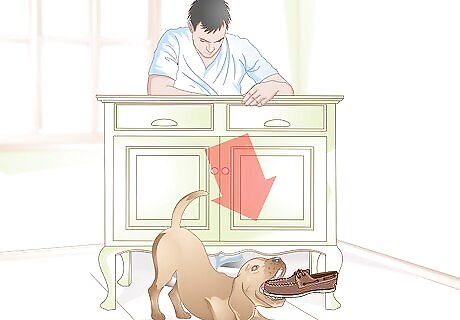
Catch your dog in the act. When punishing your dog with a spray bottle, it is very important that you punish it while it is in the act of misbehaving. Punishing your dog after the fact can cause confusion, or even make your dog think it is being punished for no reason. For example, if you find that your dog has chewed up your shoe, but you did not see your dog doing it, then going over to your dog and squirting it with the water gun will not do any good. Instead, wait for the next time you see your dog chewing on your shoe or the furniture. Use the water gun to punish your dog then. Keep your water gun hidden in your pocket or waistband at all times so that you can punish your dog in the act, and use the element of surprise to your advantage.
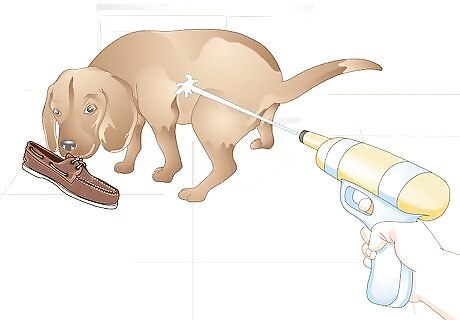
Spray your dog’s body. When you catch your dog in the act, and you have your water gun handy, avoid spraying your dog in the face. First off, by spraying it in the face, you can inadvertently harm its eyes. Secondly, your dog will be able to see that you are spraying the bottle. Thus, it will come to associate you with the punishment, and might begin to fear or resent you. Instead, spray your dog’s body, like its back or its behind. Or, try spraying your dog in the back of the head. Do not use the water gun forcefully, for example, use a high-pressure setting to spray the dog, or spray too much water. You might harm the dog this way.

Give a verbal addition. As you squirt your dog, you must give a verbal addition, like “No,” “Stop,” or “Stop, bad dog.” This way, the dog can begin to associate the punishment with the verbal correction. Once it has made a connection between the word and the punishment, you will only need to use the word to get it to stop misbehaving. Make sure your voice is confident, loud (but not yelling), and firm so that your dog understands that you are in charge and do not approve of the behavior.
Knowing What Not to Do
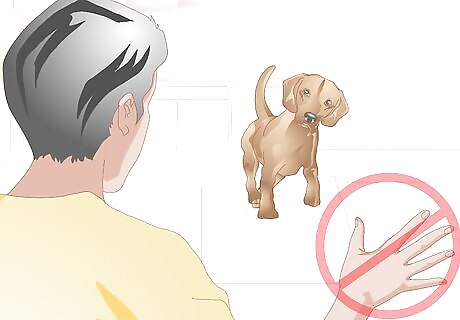
Do not call your dog over. When punishing your dog with a water gun, do not call your dog over to receive the punishment. By doing this, you are not catching your dog in the act. Instead, your dog will think that it is being reprimanded for coming to you when called, which you do not want.

Don’t let your dog see the water gun. Try not to let your dog see the water gun, or see that you are dispensing the water from the gun. The punishment should not be associated with you, but with the misbehavior. If your dog comes to associate you with the water gun, then it is more likely to engage in the behavior when you are not around. Keep the water gun in your back pocket, and make sure your dog does not see you using it. To prevent your dog from seeing you use the water gun, approach your dog from behind and spray the back of its head or body.
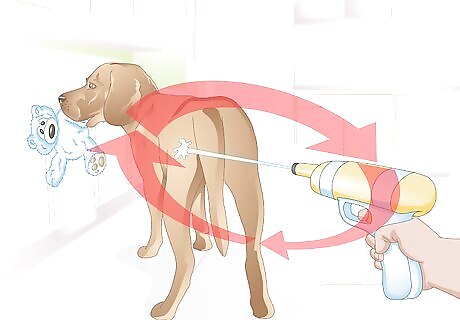
Be consistent. Try to punish your dog every time the misbehavior occurs. If you only punish your dog sporadically, then it will learn that it still occasionally gets to do the unwanted behavior. This can cause your dog to either do the behavior when you are not around, or decide that performing the behavior is worth the risk of getting punished.
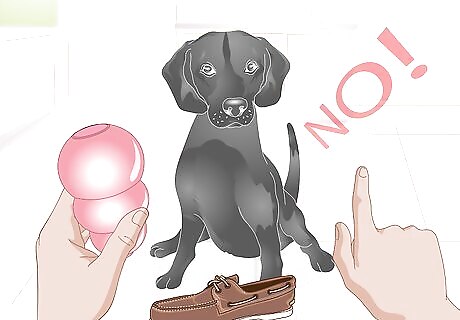
Use a different method. This method of punishment does not usually work on dogs that enjoy water, like Labradors, Golden retrievers, American and Irish water spaniels, Portuguese water dogs, labradoodles, and general retriever dogs. Therefore, you will need to use a different method of punishment if your dog likes water, or is one of these dogs. Instead, take away one of your dog's favorite toys, or place it in time-out (time-outs should not be longer than a minute). Make sure to accompany the punishment with a verbal addition like, "Bad dog" or "No." On the other hand, dogs that dislike water are Chihuahuas, pugs, Yorkshire terriers, Pekingese breeds, Dachshunds, Maltese breeds, Shih Tzus, Pomeranians, Chinese cresteds, and Lhasa Apsos.



















Comments
0 comment